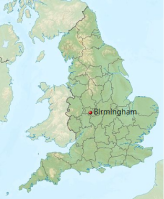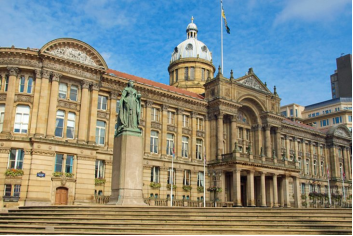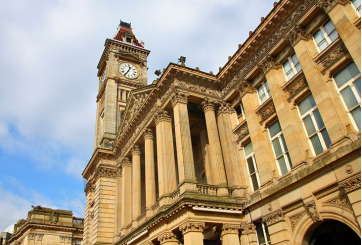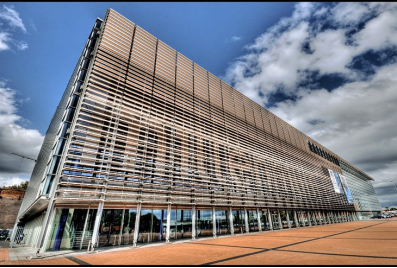Birmingham, West Midlands, England, UK 作者: 来源: 发布时间:2020-12-30
I. Population and Area
Continent:: Europe
Country: The U.K
State/Province: England
City/Town: Birmingham, West Midlands
Total Area: 103.4 (sq mi)
Population in 2018: 209.9(thousand)
II. Natural Geography (environment and resources)

Geology
Birmingham is dominated by the Birmingham Fault, which runs diagonally through the city from the Lickey Hills in the south west, passing through Edgbaston and the Bull Ring, to Erdington and Sutton Coldfield in the north east. To the south and east of the fault the ground is largely softer Mercia Mudstone, interspersed with beds of Bunter pebbles and crossed by the valleys of the Rivers Tame, Rea and Cole and their tributaries To the north and west of the fault, between 150 and 600 feet (46 and 183 metres) higher than the surrounding area and underlying much of the city centre, lies a long ridge of harder Keuper Sandstone. The bedrock underlying Birmingham was mostly laid down during the Permian and Triassic periods.
Climate
Birmingham has a temperate maritime climate, like much of the British Isles, with average maximum temperatures in summer (July) being around 21.3 °C (70.3 °F); and in winter (January) around 6.7 °C (44.1 °F). Between 1971 and 2000 the warmest day of the year on average was 28.8 °C (83.8 °F) and the coldest night typically fell to −9.0 °C (15.8 °F). Some 11.2 days each year rose to a temperature of 25.1 °C (77.2 °F) or above and 51.6 nights reported an air frost. The highest recorded temperature, set during August 1990, was 34.9 °C (94.8 °F).
Transport
Main article: Transport in Birmingham
The Gravelly Hill Interchange, where the M6 motorway meets the Aston Expressway, is the original Spaghetti Junction. Partly due to its central location, Birmingham is a major transport hub on the motorway, rail and canal networks. The city is served by the M5, M6, M40, and M42 motorways, and possibly the most well known motorway junction in the United Kingdom: Spaghetti Junction, a colloquial name for the Gravelly Hill Interchange. The M6 passes through the city on the Bromford Viaduct, which at 3.5 miles (5.6 km) is the longest bridge in the UK. Birmingham is planning a Clean Air Zone from 2020, which will charge polluting vehicles to travel into the city centre. Birmingham Airport, located 6 miles (9.7 km) east of the city centre in the neighbouring borough of Solihull, is the seventh busiest airport by passenger traffic in the UK and the third busiest outside the London area, after Manchester and Edinburgh. It is a major base for Ryanair and TUI Airways. Airline services operate from Birmingham to many destinations in Europe, the Americas, Africa, the Middle East, Asia and Oceania.
III. GDP
List of metropolitan economies by size
Metropolitan area | GDP (2012, $bn, PPP) | GDP per capita (2012, $) |
Birmingham | 114.3 | 30,896 |
IV. Industrial Characterisitics
Major industries:
Birmingham's economic base industries include established industries such as health care, primary and fabricated metals manufacturing, tourism, distribution, financial services, and emerging industries such as life sciences, digital information and media, and certain advanced manufacturing specializations.
Big projects:The Birmingham Big Art Project
Details: Art is a vital part of our city's past, present and future. We imagine new public artwork can support and expand the idea of a twenty-first-century city and perform an iconic function within Birmingham.
V. Attractions
1. Victoria Square & Birmingham City Center:

The heart of Birmingham revolves around the pedestrian-friendly Victoria Square, and can be explored via the Birmingham City Centre Path. Along the way, you'll discover the attractive old Town Hall, built in 1832 and a masterpiece of Victorian architecture. Resembling a Roman temple, this impressive structure features 40 ornate Corinthian columns made of Anglesey marble, and has been the center of the city's music scene since hosting the first performance of Mendelssohn's Elijah in 1847.
2. Birmingham Museum & Art Gallery:

The Birmingham Museum and Art Gallery, opened in 1885, is considered one of the finest such museums outside London. Its art treasures include a collection of works by Pre-Raphaelite painters, as well as artwork from the 17th to 19th centuries and sculptures by Rodin and James Tower.
3. Thinktank, Birmingham Science Museum:
Families traveling with budding young scientists won't want to miss Thinktank, Birmingham Science Museum. This award-winning museum includes a large number of fascinating science-related exhibits, many of them hands-on and interactive.

Pre-history and medieval
There is evidence of early human activity in the Birmingham area dating back to around 8000 BC,[32] with Stone Age artefacts suggesting seasonal settlements, overnight hunting parties and woodland activities such as tree felling.[33] The many burnt mounds that can still be seen around the city indicate that modern humans first intensively settled and cultivated the area during the Bronze Age, when a substantial but short-lived influx of population occurred between 1700 BC and 1000 BC, possibly caused by conflict or immigration in the surrounding area.
Early modern
The principal governing institutions of medieval Birmingham – including the Guild of the Holy Cross and the lordship of the de Birmingham family – collapsed between 1536 and 1547,[42] leaving the town with an unusually high degree of social and economic freedom and initiating a period of transition and growth.[43] By 1700 Birmingham's population had increased fifteenfold and the town was the fifth-largest in England and Wales.[44]
Industrial Revolution
Birmingham's explosive industrial expansion started earlier than that of the textile-manufacturing towns of the North of England,[61] and was driven by different factors. Instead of the economies of scale of a low-paid, unskilled workforce producing a single bulk commodity such as cotton or wool in large, mechanised units of production, Birmingham's industrial development was built on the adaptability and creativity of a highly paid workforce with a strong division of labour, practising a broad variety of skilled specialist trades and producing a constantly diversifying range of products, in a highly entrepreneurial economy of small, often self-owned workshops.[62] This led to exceptional levels of inventiveness: between 1760 and 1850 – the core years of the Industrial Revolution – Birmingham residents registered over three times as many patents as those of any other British town or city.
VII. Culture
Music
The Birmingham Triennial Music Festivals took place from 1784 to 1912. Music was specially composed, conducted or performed by Mendelssohn, Gounod, Sullivan, Dvořák, Bantock and Edward Elgar, who wrote four of his most famous choral pieces for Birmingham. Elgar's The Dream of Gerontius had its début performance there in 1900. Composers born in the city include Albert William Ketèlbey and Andrew Glover.
Jazz has been popular in the city since the 1920s,[182] and there are many regular festivals such as the Harmonic Festival, the Mostly Jazz Festival and the annual International Jazz Festival.
Theatre and performing arts
The Birmingham Opera Company under artistic director Graham Vick has developed an international reputation for its avant-garde productions,[193] which often take place in factories, abandoned buildings and other found spaces around the city.[194] More conventional seasons by Welsh National Opera and other visiting opera companies take place regularly at the Birmingham Hippodrome.[195]
The first dedicated comedy club outside of London, The Glee Club, was opened in The Arcadian Centre, city centre, in 1994, and continues to host performances by leading regional, national and international acts.
Literature
Literary figures associated with Birmingham include Samuel Johnson who stayed in Birmingham for a short period and was born in nearby Lichfield. Arthur Conan Doyle worked in the Aston area of Birmingham whilst poet Louis MacNeice lived in Birmingham for six years. It was whilst staying in Birmingham that American author Washington Irving produced several of his most famous literary works, such as Bracebridge Hall and The Humorists, A Medley which are based on Aston Hall, as well as The Legend of Sleepy Hollow and Rip Van Winkle .
VIII. Other information
In Birmingham libraries, leisure centres, parks, play areas, transport, street cleaning and waste collection face cuts among other services. Albert Bore, leader of Birmingham City Council called on the government to change radically how local services are funded and provided. It is claimed government cuts to local authorities have hit Birmingham disproportionately.[304] Child protection services within Birmingham were rated "inadequate" by OFSTED for four years running between 2009 and 2013, with 20 child deaths since 2007 being investigated.[305] In March 2014 the government announced that independent commissioner would be appointed to oversee improvements to children's services within the city.
IX. Contact information
Mayor/Officer: Mohammed Azim
Tel: 0121 303 1115
Mail: bhamcitycouncil@gmail.com
